The AMD Trinity Review (A10-4600M): A New Hope
by Jarred Walton on May 15, 2012 12:00 AM ESTAMD Trinity General Performance
Starting as usual with our general performance assessment, we’ve got several Futuremark benchmarks along with Cinebench and x264 HD encoding. The latter two focus specifically on stressing the CPU while PCMarks will cover most areas of system performance (including a large emphasis on storage) and 3DMarks will give us a hint at graphics performance. First up, PCMark 7 and Vantage:
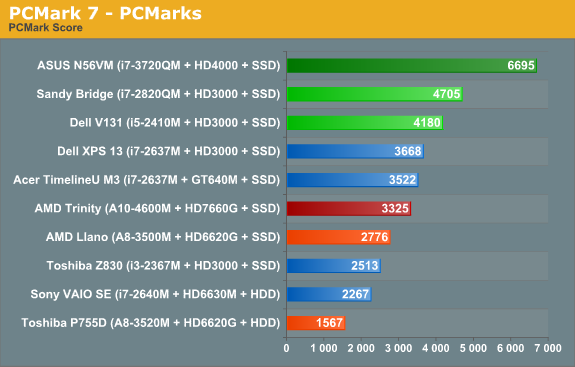
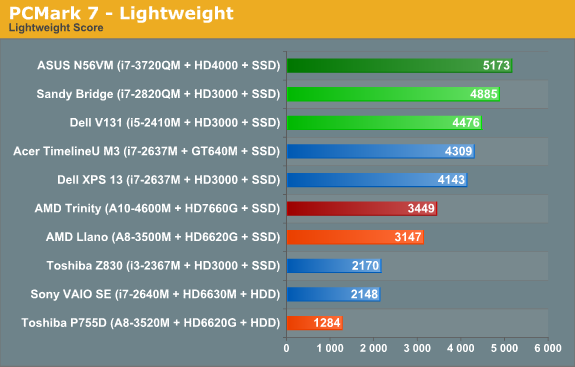
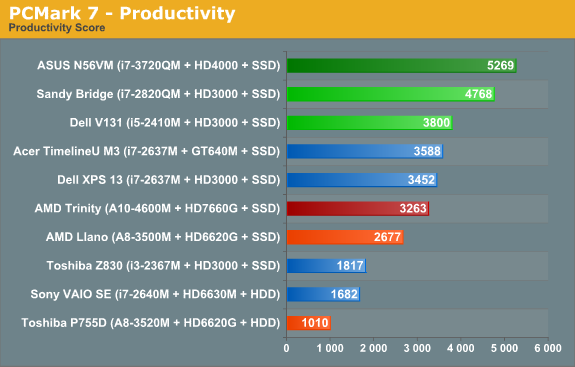

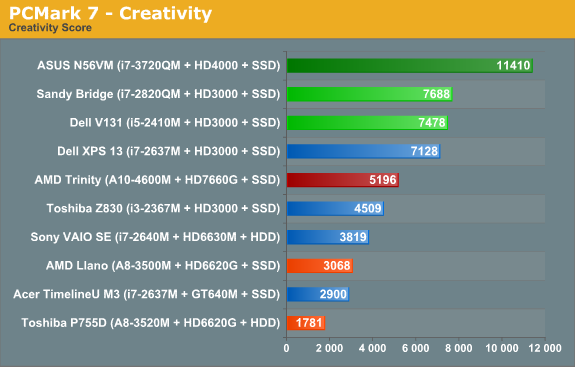
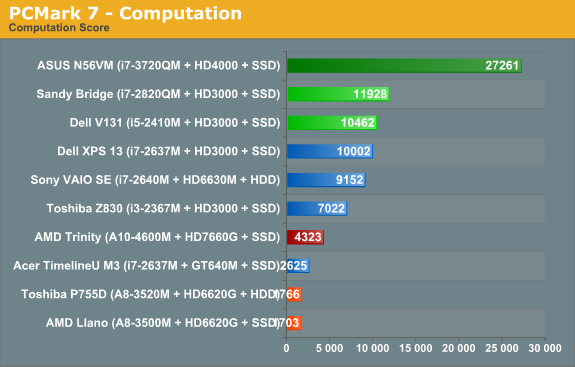
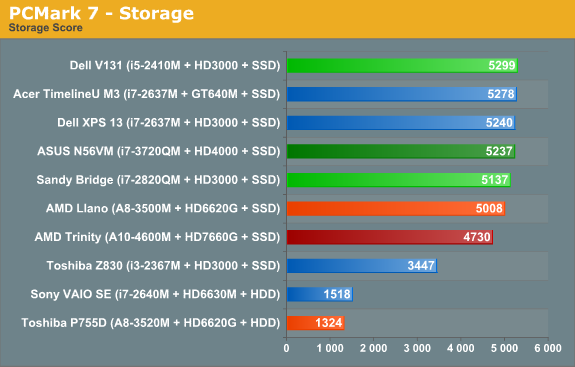
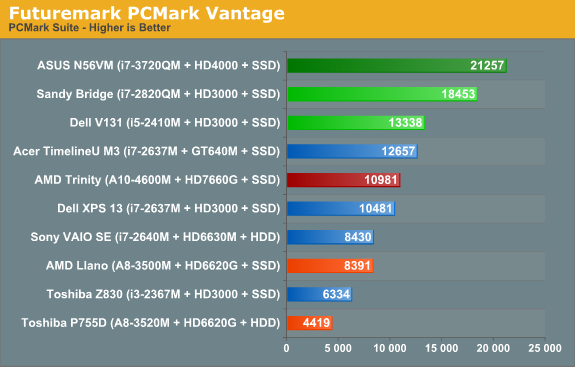
As noted earlier, we ran several other laptops through PCMark 7 and PCMark Vantage testing using the same Intel 520 240GB SSD, plus all the ultrabooks come with SSDs. That removes the SSD as a factor from most of the PCMark comparisons, leaving the rest of the platform to sink or swim on its own. And just how does AMD Trinity do here? Honestly, it’s not too bad, despite positioning within the charts.
Obviously, Intel’s quad-core Ivy Bridge is a beast when it comes to performance, but it’s a 45W beast that costs over $300 just for the CPU. We’ll have to wait for dual-core Ivy Bridge to see exactly how Intel’s latest stacks up against AMD, but if you remember the Llano vs. Sandy Bridge comparisons it looks like we’re in for more of the same. Intel continues to offer superior CPU performance, and even their Sandy Bridge ULV processors can often surpass Llano and Trinity. In the overall PCMark 7 metric, Trinity ends up being 20% faster than a Llano A8-3500M laptop, while Intel’s midrange i5-2410M posts a similar 25% lead on Trinity. Outside of the SSD, we’d expect Trinity and the Vostro V131 to both sell for around $600 as equipped.
A 25% lead for Intel is pretty big, but what you don’t necessarily get from the charts is that for many users, it just doesn’t matter. I know plenty of people using older Core 2 Duo (and even a few Core Duo!) laptops, and for general office tasks and Internet surfing they’re fine. Llano was already faster in general use than Core 2 Duo and Athlon X2 class hardware, and it delivered great battery life. Trinity boosts performance and [spoiler alert!] battery life, so it’s a net win. If you’re looking for a mobile workstation or something to do some hardcore gaming, Trinity won’t cut it—you’d want a quad-core Intel CPU for the former, and something with a discrete GPU for the latter—but for everything else, we’re in the very broad category known as “good enough”.


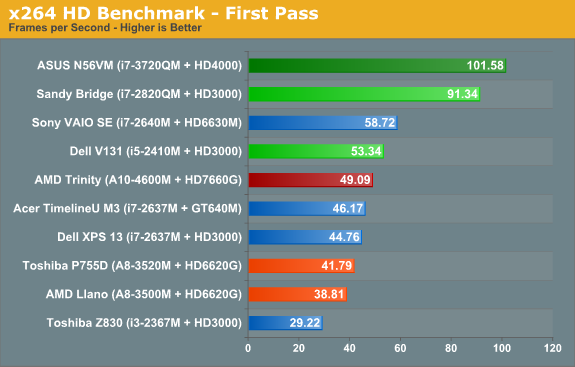
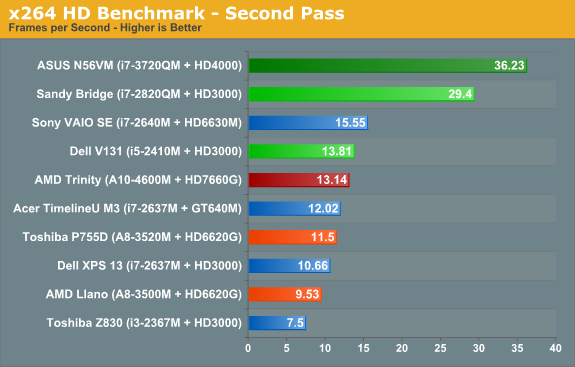
When we start drilling down into other performance metrics, AMD’s CPU performance deficiency becomes pretty obvious. The Cinebench single-threaded score is up 15% from 35W Llano, but in a bit of a surprise the multi-threaded score is basically a wash. Turn to the x264 HD encoding test however and Trinity once again shows a decent 15% improvement over Llano. Against Sandy Bridge and Ivy Bridge, though? AMD’s Trinity doesn’t stand a chance: i5-2410M is 50% faster in single-threaded Cinebench, 27% faster in multi-threaded, and 5-10% faster in x264. It’s a good thing 99.99% of laptop users never actually run applications like Cinebench for “real work”, but if you want to do video encoding a 10% increase can be very noticeable.

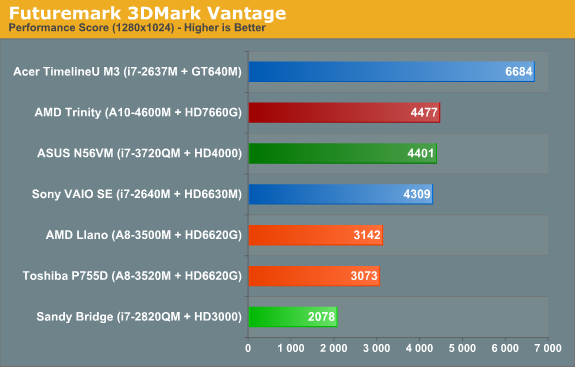
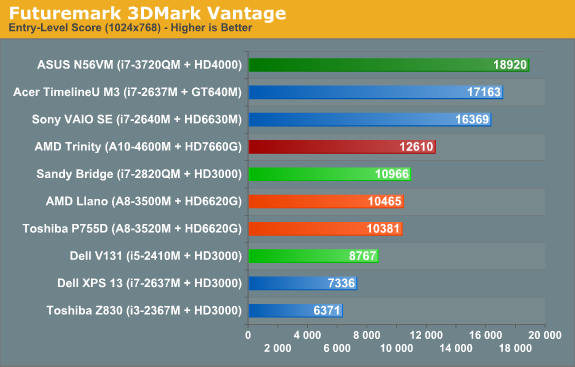
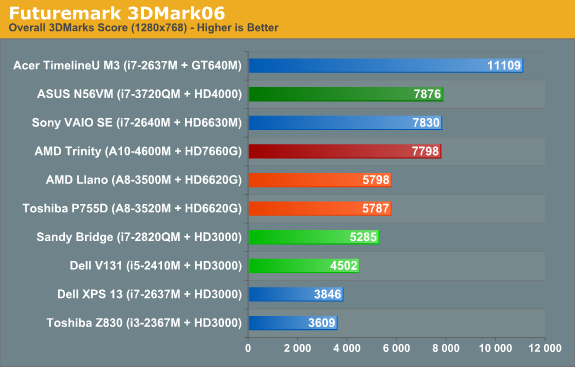
Shift over to graphics oriented benchmarks and the tables turn once again...sort of. Sandy Bridge can’t run 3DMark11, since it only has a DX10 class GPU, but in Vantage Performance and 3DMark06 Trinity is more than twice as fast as HD 3000. Of course, Ivy Bridge’s HD 4000 is the new Intel IGP Sheriff around these parts, and interestingly we see Trinity and i7-3720QM basically tied in these two synthetics. (We’ll just ignore 3DMark Vantage’s Entry benchmark, as it’s so light on graphics quality that we’ve found it doesn’t really stress most GPUs much—even low-end GPUs like HD 3000 score quite well.) We’ll dig into graphics performance more with our gaming benchmarks next.










271 Comments
View All Comments
meloz - Tuesday, May 15, 2012 - link
Quiet underwhleming. :\On the CPU side, IVB absolutely clobbers Trinity. People keep saying [FONT="Arial Narrow"]"CPU don't matter"[/FONT], but if you have a SSD the 'bottleneck' immediately shifts back to the CPU for certain tasks. It is always nice to have good single thread performance, and Intel enjoys a huge advantage in this area.
On the iGPU side, the much derided and seemingly impotent HD 4000 manages to actually narrow the lead AMD enjoyed on the graphics side. If only Intel drivers were written by people who had any clue, they would get even better performance out of their silicon.
So it will all come down to pricing. This is as much in Intel's hand as AMD's. AMD can potentially sell a lot of these things, but at a price where they won't be making any profits.
Congratulations to JW on another fine review, but a very underwhelming new product from AMD, as I said earlier.
jabber - Tuesday, May 15, 2012 - link
Trust me, no one applauds if I hold up my laptop and shout "BEHOLD THE WONDEROUS SINGLETHREADED PERFORMANCE! BASK IN IT'S POWER!!!"You are making too much of too little really.
meloz - Tuesday, May 15, 2012 - link
"You are making too much of too little really. "The marketshare and sales performance of the two rival products immediately proves you wrong. But keep digging the hole. Need a Bulldozer (or is it time for an Excavator) to speed up the processs?
jabber - Tuesday, May 15, 2012 - link
You're right, I'm obviously just not taking the issue as seriously as you are.Enjoy the endless benchmarking!
Ahem....
Taft12 - Tuesday, May 15, 2012 - link
AMD can't produce enough chips to meet demand and is improving marketshare every quarter. Their <1% quarterly increases are more like digging with a spoon, but it's digging in the right direction.medi01 - Thursday, May 17, 2012 - link
Market share means nothing, silly. Prescott had much bigger share than Athlon 64, while being inferior on all fronts.Spunjji - Wednesday, May 16, 2012 - link
Who's deriding the HD 4000? :/medi01 - Thursday, May 17, 2012 - link
If you have SSD bottleneck is your brain, that is too slow to distinguish between 22ms and 24ms.There is no way 20% faster version of an ALREADY SUCCESSFULL product is "underwhelming".
cjs150 - Tuesday, May 15, 2012 - link
Am aiming to start an HTPC build in the next couple of months. Mostly for movies but a little light gaming from time to time (Total War: Shogan on a 47" HD screen!)Low power of Trinity looked very promising...then I read Jarred's review.
Back to the i7-3770T even though the CPU+motherboard will be at least twice the price of the AMD versions.
Assimilator87 - Tuesday, May 15, 2012 - link
The desktop version of Trinity should fare better because of the TDP headroom, although it's extremely disappointing that it won't be released 'till Q3. I guess my mini-ITX case will have to sit in its box for another few months.